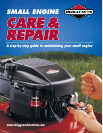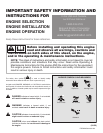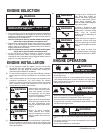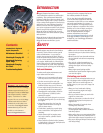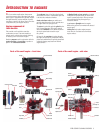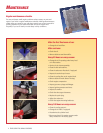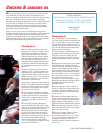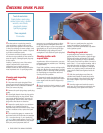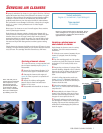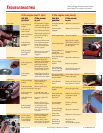
Small engines must burn fuel and induce
electricity. Each of these involves special
safety considerations—so you need to
observe the precautions for both. Keep in
mind all operational procedures as outlined
in your owners manual when working with
your engine. Additionally, by following the
simple safety rules for engine maintenance,
you will simplify the job of safely operating,
maintaining and repairing your small engine.
Safe maintenance
To make small engine maintenance and
repair tasks easier and safer:
• Make sure you have ample work space,
with easy access to the tools you need.
• Use the correct tools for each job.
• Keep an approved fire extinguisher in a
familiar location near your work area.
• Learn engine shutoff procedures so you
can respond quickly in an emergency.
• Disengage the cutting blade, wheels or
other equipment, if possible, before
starting the engine.
• Disconnect the spark plug wire to prevent
accidental starting when you are servicing
the engine.
• Always disconnect the wire from the
negative terminal when servicing an
electric starter motor.
• Check that a spark plug or spark plug
tester is attached to the engine before
cranking.
• Avoid contact with hot engine parts,
such as the muffler, cylinder head or
cooling fins.
• Never strike the flywheel with a hammer
or hard object; it may cause the flywheel to
shatter during operation.
INTRODUCTION
W HERE TO FIND US
You never have to look far to find Briggs
& Stratton support and service for your
small engine. Consult your Yellow Pages
under “Engines-Gasoline,” “Gasoline-
Engines,” “Lawn Mowers” or similar
categories. There are over 30,000 Briggs
& Stratton authorized service dealers
worldwide who provide quality service.
You can also contact Briggs & Stratton
Customer Service by phone at 1-800-
233-3723, or on the Internet at
http://www.briggsandstratton.com.
• Make sure the air cleaner assembly and
blower housing are in place before starting
the engine.
• Remove any fuel from the tank and close
the fuel shutoff valve before transporting
an engine.
• Use only the original manufacturer’s
replacement parts; any other parts may
damage the engine and create safety
hazards.
• Keep engine speed settings within
manufacturer specifications. Higher speeds
can ruin the engine.
Protecting your health
Fire, electric shock and asphyxiation are not
the only dangers when working with small
engines. Take care to avoid long-term or
sudden injury to your eyes, ears, lungs, feet
and back:
• Keep your feet, hands and clothing
away from moving engine and equip-
ment components.
• Use eye protection when you work with
engines or power tools.
• Wear ear protection to reduce the risk of
gradual hearing loss from exposure to
engine noise.
• Wear a face mask, if required, when
working with chemicals.
• Wear specially designed gloves to
protect against heat, harmful chemicals
and sharp objects.
• Wear safety shoes to protect against falling
objects; safety shoes have soles that won’t
deteriorate when exposed to gasoline or oil.
• Use proper lifting techniques and seek help
with heavy lifting.
Briggs & Stratton has been a major
force behind the explosion in small engine
popularity. This quintessential American
company builds more than two-thirds of all
lawn mower engines and is a major producer
of four-stroke small engines for almost every
application. You may find many brands of
mowers, tractors and other equipment at
your power equipment retailer. Look closely:
chances are good the engines are built by
Briggs & Stratton. Retailers like to point
this out because the name stands for quality
and experience.
Briggs & Stratton’s knowledge and expertise
is second to none. When you learn from
Briggs & Stratton technicians, you’re
learning from the company that has set
the industry standard for decades.
You’re also developing skills that apply
to more than lawn equipment. With the
information in this book, you can maintain
and repair small engines on a variety of
power equipment—from generators and
pressure washers, to hydraulic lifts. In this
booklet, we’ll cover the basic procedures
for maintaining your small engine. For
more in depth explanation of engine
systems, maintenance and repair,
go to www.briggsandstratton.com or look
for Briggs & Stratton Small Engine Care
& Repair at your local Briggs & Stratton
authorized dealer.
SAFETY
Contents
Introduction to Engines &
Engine Components 3
Maintenance Checklist 4
Checking & Changing Oil 5
Checking & Replacing
Spark Plugs 6
Checking & Changing
Air Filters 7
Troubleshooting Guide
2THE GUIDE TO SMALL ENGINES



